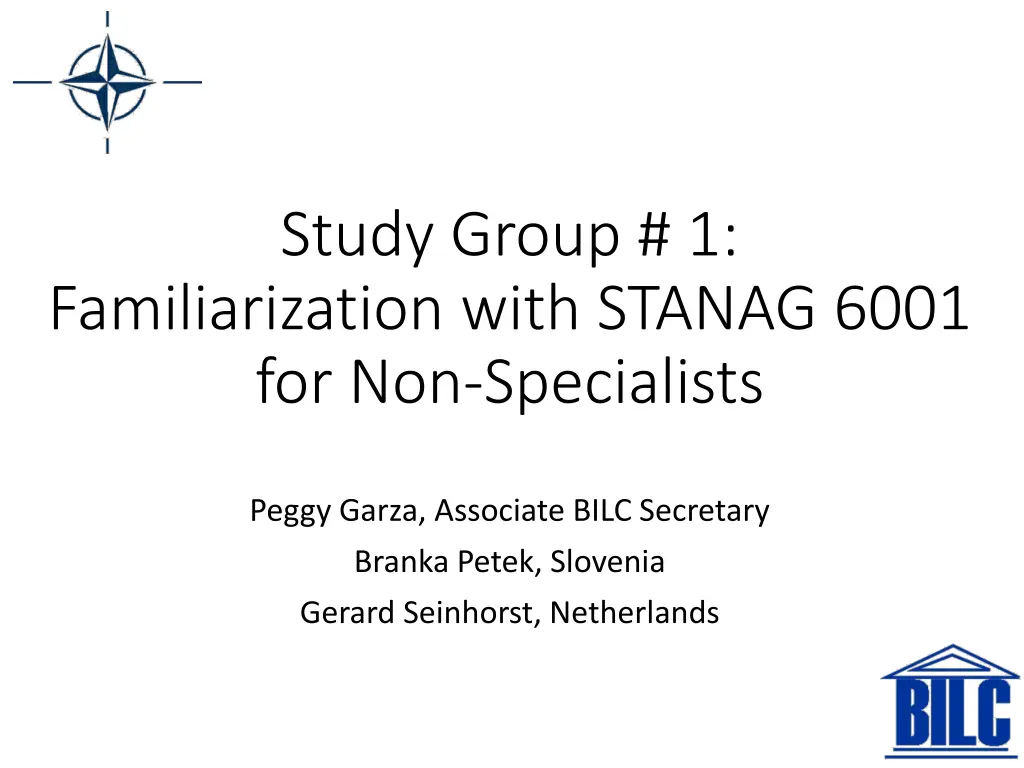
Understanding STANAG 6001 Language Proficiency Levels for NATO Non-Specialists
Gain insight into STANAG 6001 language proficiency levels for non-specialists in NATO staff positions to facilitate informed decisions on linguistic interoperability and language capabilities. Explore a prototype e-learning module and practical resources to enhance understanding and interpretation of language proficiency descriptors.
Download Presentation

Please find below an Image/Link to download the presentation.
The content on the website is provided AS IS for your information and personal use only. It may not be sold, licensed, or shared on other websites without obtaining consent from the author. If you encounter any issues during the download, it is possible that the publisher has removed the file from their server.
You are allowed to download the files provided on this website for personal or commercial use, subject to the condition that they are used lawfully. All files are the property of their respective owners.
The content on the website is provided AS IS for your information and personal use only. It may not be sold, licensed, or shared on other websites without obtaining consent from the author.
E N D
Presentation Transcript
Study Group # 1: Familiarization with STANAG 6001 for Non-Specialists Peggy Garza, Associate BILC Secretary Branka Petek, Slovenia Gerard Seinhorst, Netherlands
Study Group # 1: Familiarization with STANAG 6001 for Non-Specialists Non-language specialists in NATO staff positions should be familiar with STANAG 6001 language proficiency levels in order to make informed decisions about SLPs and other matters relating to languages such as establishing policy on linguistic interoperability, determining capability targets for languages, and using English as an operational language within NATO, etc. While the STANAG 6001 Overview for Non-Specialists and the full STANAG 6001 descriptors can be used in promoting a common understanding and interpretation of the descriptors, it has become evident that non-specialists making these decisions remain uninformed. The goals of the Study Group are to: (1) propose a prototype e-learning module building on the existing BILC documents that will include samples of language at each proficiency level and explanations; (2) explore ways to make the Familiarization with the STANAG 6001 for Non-Specialists module readily available as a practical resource for non-specialists. Description & Outcome Room: Castelo VI+VII
Study Group #1 Participants Participants Country/Organization 1 2 3 4 5 6 7 8 9 10 11 12 13 14 15 16 17 18 19 20 21 Peggy GARZA MA Gerard SEINHORST Branka PETEK Col. (ret.) Trayko STOYKOV Colonel Valerii CHURKIN Philip TURNER Michael ADUBATO Anna IVANOVA Maj Dra enMALE EVI Capt Jakov LJUBANI Irena Prpic DJURIC Col Zsolt MIKUSI Brig Gen Giovanni Francesco ADAMO Major Alessandra GIGLIOLI Anna SCATIGNO PhD Jelena KAZIMIANEC CAP Otilia MANSO LTC Jer nimo Sergio CARACUEL MART NEZ CF 3 Mariamma MARTIN Lt Col Craig MULLEN David OGLESBY USA/BILC Associate Secretary Netherlands Slovenia Bulgaria/BILC Chairman NATO HQ SACT NATO/IMS NATO/ACO SHAPE Australia Bosnia and Herzegovina Bosnia and Herzegovina Croatia Hungary Italy Italy Italy Lithuania Portugal Spain Sweden United Kingdom United States of America
Excerpt from ETEE TRA Report Findings *(para 8b - Languages) 1.Leadership at all levels are required to have awareness of the STANAG 6001, Language Proficiency Levels. 2. For Language appointed SMEs in the NCS, participation in the BILC Annual Conference, the BILC Annual Professional Seminar, and the STANAG 6001 Testing Workshop is strongly encouraged as part of their professional development programme. 3. Education in English communication is assumed a national requirement. For further professional development in English communication, several HQs offer additional internal education and training, e.g. HQ SACT s Strategies for Writing Course.
ACO Directive 040-012
Annex A, Descriptions of Standardized Language Profiles (SLPs)
Study Group Considerations ETEE Training Requirements Analysis (TRA) report Annex A, ACO Directive 040-012 ACO action officer agreed that it wasn t current and would welcome a replacement from BILC Inquiry from Joint Fires Observer (JFO) SME Tension between general language proficiency and English for occupational purposes SLP 332+2 Specific purposes test?
Three Deliverables Replacement for Annex A using STANAG 6001 Overview for Non-Specialists as a basis Draft produced Web-based interactive tool for conducting an informal Language Needs Analysis (LNA) LNA/expert advice for Joint Fires Observer (JFO) USA, Slovenia and Hungary participating nations
Way Ahead Recommend that Study Group #1 become a Working Group Plan #1 Short-term: Finalize the new draft STANAG 6001 Overview for Non-Specialists #2 Mid-term: Reach out to the JFO training centers in the USA, Hungary and Slovenia to offer expert assistance and a possible LNA #3 Long-term: Collaborate via BILC SharP Moodle platform beginning with a review of the LNA questionnaires used at HQ SACT, Geilenkirchen and in Australia; Coordinate with e-learning specialists at the NATO School who have offered to provide technical assistance
Thank you to the members of Study Group 1 for your contributions and your willingness to continue with this work. BILC is NATO s advisory body for language matters. It is important to make our expertise known and available throughout NATO.
